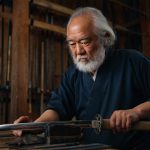
Editor: Vladimir Bajic | Tactical Investor
The Rat Race: The Death of the American Dream and the Rise of a Work-Until-You-Die Narrative
Feb 1, 2025
Time=Life. Time is your most precious asset. At a 9-to-5 job, time is a liability, not an asset.
In today’s hypercompetitive economy, the traditional American dream—characterized by upward mobility, personal fulfilment, and the promise of prosperity through hard work—has given way to a starkly different reality. Increasingly, the prevailing narrative is one of relentless labour: work until you die. This new paradigm, which some have dubbed “the rat race,” forces employees into a life of exhaustion, stress, and deteriorating health, all while rewarding corporate interests at the expense of individual well-being. This essay examines how outdated work schedules, particularly the rigid 9-to-5 model, contribute to a host of problems—from disrupted circadian rhythms and diminished productivity to a devaluation of time as our most precious asset—and explores how mass psychology, cognitive biases, and innovative out-of-the-box thinking, epitomized by concepts such as the “Burro Theory,” can help us chart a more humane and effective path forward.
The Hidden Costs of the 9-to-5 Grind
The 9-to-5 workday has been hailed as the epitome of professionalism and productivity for decades. Yet, emerging research from Oxford University suggests that forcing employees to start work before 10:00 AM is counterproductive and potentially harmful to both physical and mental health. Dr. Paul Kelley, an Oxford researcher and former headteacher, has extensively studied human circadian rhythms—the internal biological clocks that govern sleep, mood, and overall performance. His findings indicate that before the age of 55, adults’ circadian rhythms are fundamentally misaligned with traditional early work hours.
Dr. Kelley states these early start times disrupt the body’s natural cycles. The average 10-year-old, for instance, cannot focus effectively until around 8:30 AM, while a 16-year-old performs optimally only after 10:00 AM. University students, too, are shown to achieve better academic outcomes when their classes begin later in the morning—ideally at 11:00 AM. Kelley’s experience in education, where he shifted a school start time from 8:30 AM to 10:00 AM, resulted in a dramatic 19% increase in top grades. These observations underscore a vital point: the rigid structure of the traditional workday is at odds with our biological makeup, leading to widespread sleep deprivation, stress, and health problems.
The Physiological and Psychological Toll
When companies insist on early start times, they inadvertently set the stage for a cascade of negative effects. Employees are forced to wake up before their bodies are ready to accumulate sleep debt, which, over time, can result in chronic fatigue, diminished cognitive function, and a host of physical ailments. Dr. Kelley warns that sleep-deprived workers suffer not only from poor mental health but also from significant physiological strain. Key bodily systems, including the liver and heart, operate on distinct schedules, and forcing them to adapt to an unnatural rhythm can lead to long-term damage.
Moreover, disrupting circadian rhythms does not merely affect individual health—it undermines productivity. Studies show that when employees are not functioning at their optimal biological peak, errors increase, creativity diminishes, and overall output suffers. In essence, the 9-to-5 schedule is a double-edged sword: it extracts more time from individuals while reducing their work quality and efficiency. This dynamic is a classic example of how an institutional norm, maintained for the sake of tradition, can become a liability rather than an asset.
The American Dream in Crisis: A Work-Until-You-Die Paradigm
Beyond the immediate health and productivity issues, the rigid 9-to-5 workday is symptomatic of a broader societal problem. The American dream, once defined by the promise of upward mobility and personal fulfilment through hard work, has morphed into a gruelling pursuit of survival. The modern workplace increasingly operates as a mechanism for corporate profit, where employees are seen as replaceable cogs rather than valued individuals.
A typical 9-to-5 job is designed not to enrich the worker but to enrich the employer. The economic structure of modern corporations is such that profits are funneled upward, while workers receive only a survival wage. This phenomenon is not accidental—it is a consequence of deliberate policies and corporate practices aimed at maximizing efficiency and minimizing labor costs. In this system, the value of time is perverted: rather than being seen as a finite, non-renewable resource, time is measured in hours clocked at the office, with little regard for the quality of life or personal fulfillment.
Employees are constantly under the threat of job loss due to factors that are often beyond their control—economic recessions, automation, or even mere shifts in corporate strategy. The constant anxiety of potentially being fired or rendered obsolete compounds the stress of an already demanding work schedule. This relentless pressure creates a vicious cycle where workers are forced to sacrifice their health, personal lives, and future well-being for the sake of immediate survival. In essence, the modern rat race demands that employees work until they are physically and emotionally depleted.
Time: The Ultimate Non-Renewable Resource
Time is the one asset that cannot be replenished. Unlike money, which can be earned, saved, and reinvested, time is gone forever once lost. Yet, in the modern workplace, time is treated as an expendable commodity—a mere metric to be filled with as many billable hours as possible. The 9-to-5 job, with its rigid structure and inflexible hours, exemplifies this tragic misallocation of our most precious resource.
This fixation on time as a measure of productivity is rooted in what behavioral economists refer to as a “vanity metric.” Employers and policymakers alike are enamoured with quantifiable measures such as hours worked, even though longer hours do not necessarily translate into higher output. Studies have consistently shown that productivity plateaus after 40 hours per week, with additional hours often leading to diminishing returns. Yet, the cultural narrative persists that longer hours equal greater success, reinforcing the destructive cycle of overwork and burnout.
The Role of Mass Psychology and Cognitive Biases
The endurance of the 9-to-5 model is not simply a matter of tradition or economic necessity—it is also a product of mass psychology and cognitive biases that shape our perceptions of work. The human mind is prone to certain systematic errors in judgment, such as the status quo bias and loss aversion, which can trap us in outdated modes of thinking.
Status Quo Bias:
Many individuals naturally gravitate toward the familiar, even when it is objectively harmful. The status quo bias makes it difficult for workers to envision alternatives to the traditional workday, despite overwhelming evidence that flexible schedules could enhance both well-being and productivity. The inertia of tradition keeps employees locked into a system that is misaligned with their natural biological rhythms and personal needs.
Loss Aversion:
Loss aversion further complicates the matter. The fear of losing a stable job—even one that saps vitality and joy—often outweighs the potential gains of pursuing a more flexible and fulfilling work arrangement. This cognitive bias leads many to cling to the security of a predictable paycheck, even when that security comes at the cost of long-term health and happiness.
Mass Psychology and Herd Behavior:
Mass psychology amplifies these individual biases. When a critical mass of employees accepts the norm of early work hours and long days, that behaviour becomes self-reinforcing. The widespread belief that one must endure the rigors of a 9-to-5 job to succeed creates a powerful social pressure that discourages dissent and innovation. As more people conform to this standard, the idea of challenging the system—even in the face of compelling evidence to the contrary—becomes almost unthinkable.
The Burro Theory: Avoiding the Donkey Mentality
At the heart of these cognitive traps lies what has been colloquially termed the “Burro Theory.” This theory posits that without applying common sense and critical thinking, individuals will follow the herd—much like a stubborn donkey, blindly trudging along the same path without question. In the context of the modern workplace, the Burro Theory serves as a stark warning: failing to challenge the entrenched norms of the 9-to-5 model means accepting a life of perpetual overwork and diminished quality of life.
The Burro Theory urges us to ask: Are we truly optimizing our lives by adhering to an outdated work schedule that undermines our natural biological rhythms and devalues our time? Instead of accepting the status quo, we must employ common sense, question established practices, and explore innovative alternatives that prioritize health, creativity, and personal fulfilment.
Out-of-the-Box Solutions: Reimagining Work for a Healthier Future
The current crisis in work culture calls for radical, out-of-the-box thinking. Rather than continuing to force employees into a mould that is clearly at odds with human biology, it is time to reimagine how work is structured and valued. Several innovative approaches offer promising alternatives to the traditional 9-to-5 grind.
Flexible Work Hours:
One of the simplest yet most effective changes would be adjusting start times to align with natural circadian rhythms. As Dr. Kelley’s research suggests, beginning the workday at 10:00 AM or later could significantly improve productivity and well-being. Companies that have experimented with flexible hours report higher employee satisfaction and measurable gains in efficiency and creativity.
Remote Work and Hybrid Models:
The rapid expansion of remote work, accelerated by recent global events, has demonstrated that location and rigid schedules are not prerequisites for productivity. Hybrid work models allow employees to choose when and where they work and can reduce stress, cut commuting time, and create a better balance between professional and personal life. This flexibility empowers workers to organize their day around their most productive hours rather than conforming to an arbitrary schedule.
Results-Driven Work Environments:
In a results-driven work environment, the emphasis shifts from the number of hours worked to the quality and impact of the work produced. Organizations can incentivise creativity and innovation by focusing on outcomes rather than time spent in the office. This approach challenges the long-held notion that longer hours equate to higher productivity, instead rewarding efficiency and effective problem-solving.
Technological Solutions:
When harnessed correctly, technology can play a pivotal role in reshaping work culture. Digital tools that facilitate collaboration, task management, and performance tracking can help organizations avoid time-based metrics. Instead, data-driven insights can optimize workflows and allocate resources more effectively, ensuring that every hour of work contributes meaningfully to organizational goals.
The Psychological Shift: Reclaiming Time as Life
Central to any discussion about the death of the American dream and the rise of the work-until-you-die narrative is a fundamental revaluation of time. Time is our most precious, non-renewable resource. When we allow corporate systems to dictate how we spend our hours, we risk losing sight of what truly matters—our health, our relationships, and our personal fulfilment.
The current model of relentless labour depletes our time and erodes our sense of purpose. Instead of living a life defined by creative pursuits, personal growth, and meaningful connections, we find ourselves trapped in a cycle of exhaustion and disenchantment. The message is clear: we must reclaim our time and redefine our priorities if we are to restore the promise of the American dream.
Bridging the Gap: Policy, Culture, and the Future of Work
Transforming the modern workplace will require a concerted effort across multiple levels—individual, corporate, and governmental. Policymakers must recognize that the health and well-being of the workforce are inextricably linked to national productivity and economic stability. Legislative initiatives that promote flexible work hours, remote work options, and comprehensive employee wellness programs can help drive this change.
Corporations, too, have a responsibility. Forward-thinking companies that invest in their employees’ well-being and adopt flexible work practices often see a corresponding boost in morale and productivity. These organisations can foster a more innovative and sustainable work environment by rethinking traditional performance metrics and prioritizing outcomes over hours clocked.
On a cultural level, we must challenge the deeply ingrained belief that hard work is synonymous with self-sacrifice. The glorification of the 9-to-5 grind must give way to a more balanced narrative—one that values personal well-being, creativity, and lifelong learning. Education and public discourse should highlight the importance of aligning work with human biology and the inherent worth of each individual’s time.
Conclusion: A Call for Common Sense and Critical Thinking
The narrative of the modern rat race—where the American dream is sacrificed on the altar of relentless labor—is both unsustainable and inhumane. The evidence is compelling: forced early work hours clash with our natural circadian rhythms, resulting in health issues, reduced productivity, and a life that is lived in a state of perpetual exhaustion. The 9-to-5 model, once a symbol of stability, now appears as a relic of a bygone era—one that benefits corporate profits at the expense of human potential.
By understanding the cognitive biases and mass psychological forces at play, as encapsulated in the Burro Theory, we can begin to break free from these destructive patterns. We must embrace out-of-the-box thinking and adopt innovative models that prioritize flexibility, efficiency, and, above all, human well-being. Whether through flexible work hours, remote work, or a shift toward results-driven performance, the future of work must be reimagined to honour our most valuable asset: time.
Reclaiming our time means reclaiming our lives. It is time to reject the outdated narrative of work until you die and forge a new path that balances the demands of productivity with the need for rest, creativity, and personal fulfilment. As we move forward, let us challenge the status quo with common sense, critical thought, and a willingness to rethink the very nature of work. In doing so, we can create a society where the American dream is not a distant memory but a living, breathing reality—one in which every individual is empowered to live fully, healthily, and on their own terms.
The call to action is clear: by harnessing the insights of modern research, embracing innovative work practices, and overcoming the cognitive traps that bind us to outdated models, we can transform the rat race into a vibrant landscape of opportunity and well-being. The death of the American dream is not inevitable; it is a challenge to be met head-on with creativity, resilience, and a steadfast commitment to revaluing what truly matters—our time, our health, and our humanity.
In the end, the future of work is not about clocking endless hours at a desk but about making every moment count. By rejecting the tyranny of the 9-to-5 and reclaiming our right to live in sync with our natural rhythms, we can build a more just, innovative, and fulfilling society—one where the promise of the American dream is revived, redefined, and made attainable for all.
Enlightened Minds: Harnessing the Power of Revolutionary Ideas










